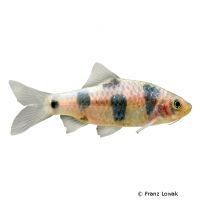Bigspot Barb (Barbodes dunckeri)
| Bigspot Barb Barbodes dunckeri | |
|---|---|
| Name | Bigspot Barb |
| Name Lat. | Barbodes dunckeri |
| Synonym | Puntius dunckeri |
| Family | Carps |
| Family lat. | Cyprinidae |
| Order | Carps |
| Order lat. | Cypriniformes |
| Origin | Malaysia |
| Habitat | Forest streams |
| Diet | Omnivore |
| pH | 6.0-7.5 |
| Behavior | Peaceful |
| Keeping | Group |
| Care Level | Moderate |
| Reproduction | Egg scatterer |
| Breeding | Difficult |
| Life Span | 5-8 years |
| Protection | No |
| Metric Units | |
| Size | 11 cm |
| Temperature | 22-30 °C |
| Hardness | 2-12 °dH |
| Aquarium | ~ 250 l |
| US Units | |
| Size | 4.3" |
| Temperature | 72-86 °F |
| Hardness | 36-214 ppm |
| Aquarium | ~ 65 gal |
Distribution and habitat
The distribution area of Dunckers barbels is the Malay Peninsula. They live mostly in the shallow margins and stillwaters of tributaries and forest streams with root, gravel and stone covered bottoms and dense riparian vegetation.
Maintenance
The aquarium should have a dense border planting, with hiding and retreat possibilities (roots, stones) and offer sufficient swimming space. In somewhat shaded light (floating plants), a dark substrate covered with some foliage (e.g. sea almond leaves) and soft, slightly acidic water they show the most beautiful coloration.
No ammonia, ammonium and nitrite must be detectable in the water, the nitrate value must not exceed 50 mg/l. To ensure the water quality and oxygen content, a filter and heater adapted to the aquarium size is required, as well as lighting for the species-appropriate day-night rhythm of the animals.
Diet
In the wild they feed on worms, insect larvae, small crustaceans and detritus. The food supply consists of live, frozen and dry food. For a balanced diet, feed them once a day with a high-quality dry food (flakes, granules, pellets) as well as daphnia, moina, artemia, mosquito larvae, etc. (live or frozen). In addition, they need regular plant food, such as algae leaves, algae wavers, scalded leafy and wild vegetables or dry food with high plant content (spirulina, kelp)
Only feed as much as will be eaten within a few minutes. A regular and varied diet promotes health and increases resistance.
Behaviour and compatibility
They are lively, peaceful schooling fish that can be kept well in a community aquarium with other peaceful fish. A group of at least 5-10 animals should be maintained. In too small groups they usually remain shy and stay hidden. Basically, only compatible fish species with similar requirements to the water condition and water temperature may be socialized.
Sex dimorphism
The males are significantly smaller, slimmer and more intensely colored than the more rounded appearing females.
Reproduction and breeding
They are free spawners. The male usually swims around (drifts) the female in the early morning, which spawns among fine-feathered plants. The larvae hatch after 24-48 hours and swim freely after 2-3 days. The parents do not engage in brood care and should be separated from the fry after spawning as they are spawn predators.
Fry must be fed several times a day with special rearing food (Artemia nauplii). Breeding is hardly possible in community tanks, as the spawn is easy prey.
Important
The foliage (sea almond tree, oak, etc.) enriches the water with humic substances, naturally lowers the pH and, when rotting, promotes the development of microorganisms, which are a valuable secondary food source.
The well-being of the fish should be monitored regularly. Temperature should be checked daily, pH, hardness and nitrate levels should be checked at least every 14 days. Regular partial water changes are recommended, even when contaminant levels have not yet reached the upper limit. Sudden changes in water quality should be avoided. Newly introduced fish must be accustomed slowly to the water in the aquarium.
Further literature can be found in your pet store.
References
Text: Sylvia Hos; Image: Franz Lowak
Source: BMELV (1998): Tierschutzgutachten - Haltung von Zierfischen (Süßwasser); BAENSCH & EVERS (2004): Aquarien Atlas Bd. 6, Mergus Verlag; ENGELMANN (2005): Zootierhaltung - Tiere in menschlicher Obhut: Fische, Verlag Harri Deutsch
- Gemäß § 21 Abs. 5 Tierschutzgesetz idgF
